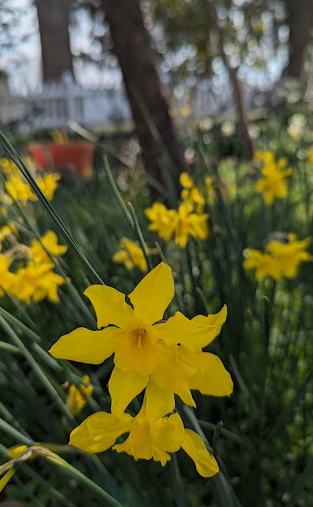Golden Spider Lilies
- Clifford Brock
- Oct 3, 2021
- 2 min read
Updated: Oct 3, 2021
Recently I posted some photos of Lycoris aurea growing at my mom's house, and it sparked some curiosity. Many people didn't know there was a yellow counterpart to the iconic red spider lily. Also known as "golden spider" or "golden hurricane," this lycoris is quite uncommon in our area of Georgia, the central piedmont; however, it is more abundant in the deep south, particularly along the Gulf and Atlantic. In fact, one of the common names of this species," St. Augustine Lily," refers to its local abundance around America's oldest city, St. Augustine. Moreover, the name "hurricane" refers to its fall bloom time, which often coincides with hurricane season.

My exposure to this plant occurred relatively recently. In 2011 I was working at Plant Delights Nursery in Raleigh, NC. One autumn day, I was wandering a path near Mount Michelle, a large man-made hill with a winding path to the summit. I remember seeing a huge clump of yellow spider lily growing at the base of a large Chinaberry tree. The memory of its bright golden flowers juxtaposed with the gray bark is forever etched into my mind. It must have been in the evening because the lighting was perfect, and the clump had what seemed like a dozen 3 ft. tall flowers. I was lovestruck! Encounters like this are what create obsessions.
So around five years ago, I attempted to mimic Tony's example and planted some bulbs near the base of a dogwood tree. And this year, I am happy to report that I have a sizeable multiplying clump of perhaps 5 scapes; a scape is the botanical name for flower stalk. It should be noted that while this species does multiply, it does so at a rate slower than the more common red spider lily. The leaves will emerge just after flowering and remain green during the winter. They can be distinguished from the red spiders by being much wider and a lighter shade of green. And as with all bulbs, it is essential not to cut or mow the leaves until they turn yellow, usually by March or April. A premature cut will result in no flowers the following fall.

For many years this species was considered too tender for anything north of the coastal plain, yet I haven't lost a single bulb to cold. Granted, a cold snap may burn the foliage, especially if it dips below 20F. And if the winter foliage is severely damaged, it may not have enough energy to bloom the following fall. However, given our increasingly mild winters, this is rarely an issue. Perhaps one silver lining to climate change is all the additional plants that will be available to us.
Finding this plant for sale is almost impossible at most nurseries. I have seen bulbs at Pikes, though inconsistently. There are a handful of online nurseries that offer it but expect to pay around $10 per bulb. Though once established, your plant should multiply and can be divided every couple of years. This process can be slow, but it is very satisfying... I've now accumulated around 15 specimens mostly through my own propagation. If you love the red spider lily, I'd urge you to grow the yellow one.




Comments